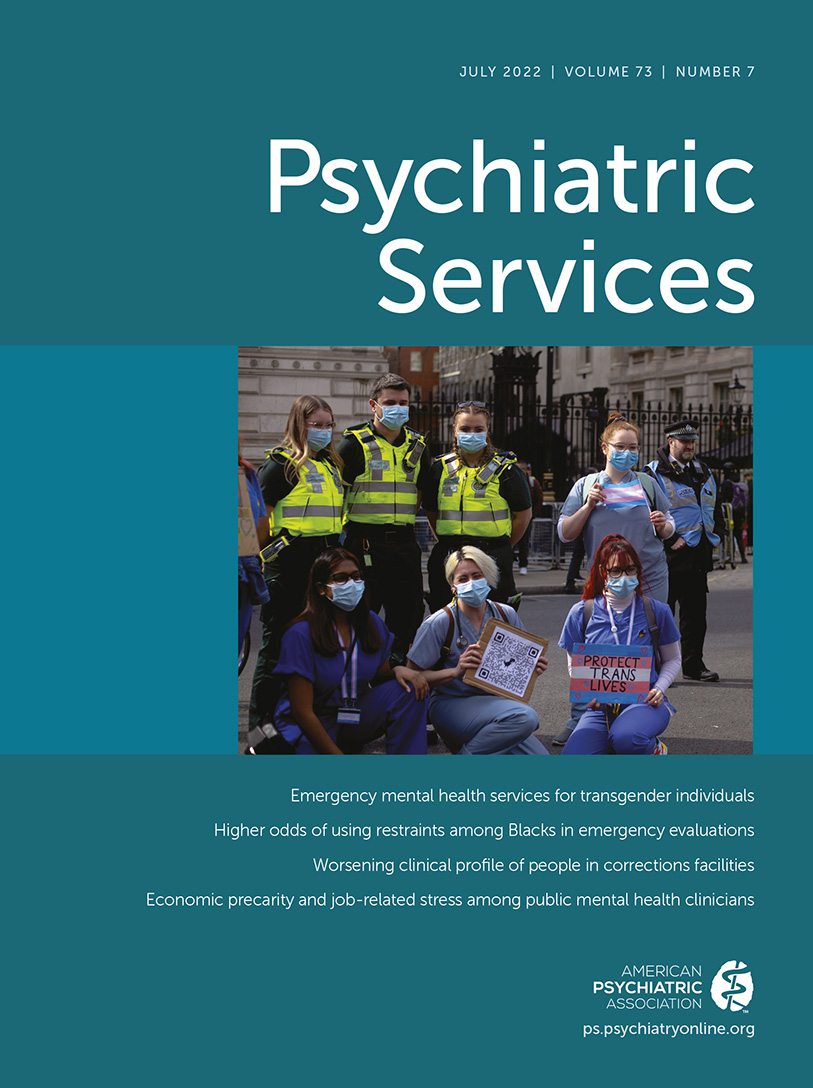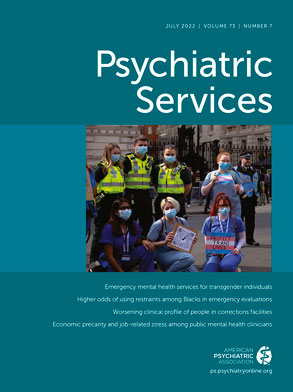Social distancing requirements due to the COVID-19 pandemic led to substantial and extraordinarily rapid changes in psychiatric service delivery, with a push toward remote consultation wherever possible. But do video calls work for people with acute, severe mental disorder? The pandemic and its associated lockdowns have been associated with increases in mental distress at the population level (
1), but what has been the impact on patients presenting with mental disorders to secondary care services? This column describes the experience of a mental health home treatment team in the United Kingdom in the months after the first wave of the pandemic. We describe how we adapted our practice, lessons learned, and the changes in caseload we observed after the lockdown.
Home Treatment Model
Crisis Resolution and Home Treatment teams in the United Kingdom provide care and treatment to those with an acute, severe mental disorder, providing an alternative to hospital admission where it is safe to do so and facilitating early hospital discharge. Edinburgh’s Intensive Home Treatment Team (IHTT) was launched in 2008 and had a positive impact on admission rates and durations and patient and caregiver satisfaction (
2). It is a 24/7 multidisciplinary service that provides intensive, short-term, home-based care for individuals ages 18–65 years who reside within Edinburgh and are experiencing a crisis due to mental distress or illness. Patients can be referred by any secondary care mental health service or emergency social work or via the Edinburgh crisis center. Triage and assessments for admission to treatment by the IHTT team are performed by two senior nurses on the team. Patients are seen regularly (up to three times daily) in their own home or outpatient clinic by psychiatrists, community psychiatric nurses, occupational therapists, support workers, and a team psychologist. The number of patients who can be taken on is unlimited. Edinburgh is the capital of Scotland, and is relatively affluent. In 2020, it had a population of 537,000 people, about 8% of whom were from Black and racial-ethnic minority groups in the 2011 census (
https://www.scotlandscensus.gov.uk/ods-web/area.html).
Lockdown in Scotland
Scotland began implementing pandemic-related restrictions in March 16, 2020, when avoidance of unnecessary social contact was first officially advised. On March 23, 2020, a lockdown across the United Kingdom was announced, with guidance that people should go outside only to buy food, exercise once a day, or commute to work if they could not work from home. This lockdown was eased in Scotland on May 28, 2020. Phased reductions in restrictions occurred during early summer, with shops, hospitality establishments, and visitor attractions reopening on July 15, 2020, but some limitations on social interaction remained in place. Restrictions were then tightened again on a regional basis, with increased restrictions imposed for those in the catchment area of the IHTT team on October 9, 2020.
Changes to the Team Process
To minimize the risk for severe acute respiratory syndrome coronavirus 2 (SARS-CoV-2) transmission between staff and patients, staff were advised to avoid face-to-face contact where possible, screen households for symptoms before visiting, and wear personal protective equipment (PPE).
Video calls and telephone calls were used by many mental health community teams to assess and treat patients and were also offered to IHTT patients. However, several challenges were identified when implementing this alternative service delivery, and so most contacts remained face to face for multifactorial reasons. Many patients were not known to the team previously, meaning that establishing rapport and a high-quality psychiatric and risk assessment were crucial and were much easier to conduct face to face. Many patients were acutely unwell with psychosis and experiencing paranoid beliefs regarding video calls and other technology. Moreover, many patients did not have the skills or equipment (a smartphone or computer) required for a call, and staff were initially provided with insufficient equipment. Further, a home visit made it easier to provide support to caregivers. To reduce the risk for transmission within homes, patients were asked to attend the hospital outpatient clinic for appointments far more often than previously, with transport provided (and paid for) when necessary.
Screening for COVID-19 symptoms in the household was done by telephone before a visit. This screening largely worked well, although in one instance a patient reported that a household member had tested positive for SARS-CoV-2 who then denied this positive test result. Because this individual was not the team’s patient, it was not possible to check their records for clarification.
As face masks are a physical barrier to the nuanced nonverbal communication offered by facial muscles, they posed challenges to establishing rapport and made the mental state examination more uncertain. One patient with psychosis commented that staff were wearing masks to conceal their identities. Some patients asked staff to briefly lower their masks to show their faces before commencing a consultation. Unmasked faces therefore were one benefit of video calls. In addition to use of PPE inside homes, cars used for transporting staff to visits were also cleaned between patient visits.
Despite the large number of community visits, no instance of COVID-19 occurred within the team, and sick leave did not increase, remaining constant at 5% of total scheduled work hours in 2018–2020. Although several staff members required time off for self-isolation while SARS-CoV-2 infection was excluded, self-isolation reduced at most 2.2% of total scheduled work hours.
Changes to Caseload
The clinical impression had been that acute mental health services in Edinburgh experienced an increase in cases of psychosis requiring urgent care within a few weeks after the start of the lockdown, both among people with established psychotic illnesses and among those with little or no previous history of psychotic symptoms. Very few of these cases were known to have had COVID-19. This observation received some support from published work, with early case series highlighting a potential increase in brief psychotic disorder associated with COVID-19 lockdowns (
3,
4). An increase in the proportion of admissions for psychosis was seen in Leicester, United Kingdom, during the first 4 weeks of the lockdown (
5). However, all of these reports were within 2 months of the start of a national lockdown. Given our clinical observation of a time lag between lockdown and symptom onset, we examined data from IHTT over a longer period. We compared cases from May to September 2020 (the “postlockdown period” when the peak in psychosis was observed) with the same months in 2018 and 2019 (
Table 1).
During the postlockdown period, we observed a 42% increase (from N=76 to 108) in the number of patients with psychosis compared with the average number for the same period in 2019 and 2018. Cases of first-episode psychosis (FEP) doubled, as did the number of women with psychosis. Acute and transient psychosis was the first subtype of psychosis that increased (May peak), with a fourfold increase in 2020, followed by nonorganic psychosis not otherwise specified (June peak), with numbers doubling in 2020. Mania with psychosis cases increased by 50% (from N=12 to 18) in 2020. The frequency of psychotic disorders that are typically more chronic (such as schizophrenia, schizoaffective disorder, and delusional disorder) did not greatly differ from frequencies seen in 2018 and 2019. Only small numbers of cases and no clear trends of drug-induced psychosis and depression with psychotic symptoms were observed. The number of cases of mood disorder (without psychosis) exhibited a small (24%, from N=63 to 48) reduction in 2020. Numbers of patients with personality disorder, anxiety/adjustment disorders, and other diagnoses remained constant in 2018, 2019, and 2020. Surprisingly few patients experienced psychosis with content relating to COVID-19, including those with FEP.
Why did the number of cases of psychosis, particularly FEP increase during the postlockdown period? The observational nature of the data meant that it was impossible to make any conclusions regarding causality, and random variation could not be excluded. However, one potential explanation is the increased stress at the societal and individual levels evoked by the pandemic and its associated lockdowns. Supporting this assumption, surveys conducted in Hong Kong (
6) and South Korea (
7) early in the pandemic showed high levels of prodromal psychotic symptoms in the general population. Psychosocial stress is particularly relevant in the etiology of acute and transient psychotic disorders (
8), the psychotic diagnosis for which we observed the largest increase.
It is possible that psychosis levels did not increase in the population in Edinburgh but that care services had shifted referral practices. As lower-intensity community services were less able to care for patients, these services may have had a lower threshold for referral to home treatment. However, the home treatment team continued to triage referrals as usual throughout the lockdown period, with no lowering of the team’s threshold for acceptance. It is plausible, however, that a reduction in access to community services meant that the conditions of some patients deteriorated more than they would have done without this reduction, to the point of requiring intensive home treatment. Primary and secondary health services switched to being primarily telephone only and may have missed early signs of illness or relapse, while third-sector organizations (which provide a lot of support and monitoring to patients with established diagnoses) largely shut down altogether.
Although COVID-19 has been associated with psychosis, particularly in the context of delirium (
9), COVID-19 directly causing psychosis seems an unlikely cause in our setting. Only a very small number of patients were known to have ever tested positive for COVID-19 or to have had symptoms during their home treatment. The gender-specific increase in psychosis among women we observed is also notable. Early lockdown surveys identified disproportionately higher levels of mental distress among women (
1). These higher levels of distress may relate to women being particularly likely to experience the adverse social determinants of mental health, which are worsened by lockdowns, for example, by increasing the likelihood of loss of a low-income job and the risk for being a victim of domestic abuse (
10).
Conclusions
The key lesson learned in this study was that video calls largely did not work for treating people with acute, severe mental disorders who required home services. Face-to-face contact continued throughout 2020 largely at normal frequencies, despite difficulties in implementing measures to minimize SARS-CoV-2 transmission. The implication for less acute services is that they may also be able to successfully provide face-to-face contact during any future lockdowns. The main lesson learned about team caseload was that more cases of psychosis were seen after COVID-19 lockdowns, particularly FEP and particularly among women. If our findings are replicated in other settings, the implication for policy makers and services would be that future pandemic preparedness include psychosis preparedness.
Acknowledgments
The authors thank Dr. Ihsan Kader for comments on the manuscript and Mr. Matt Senior for data on staff sickness levels.

